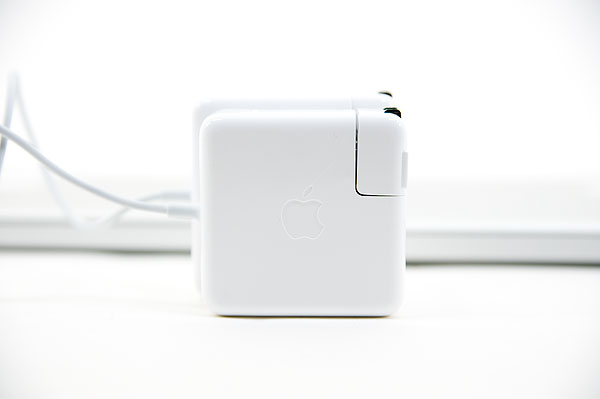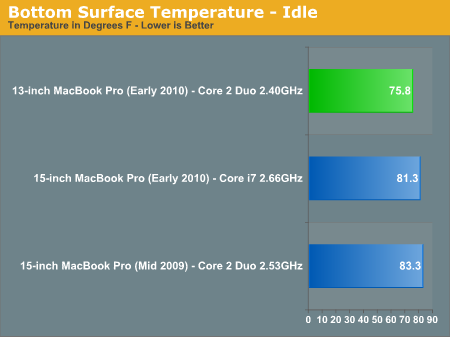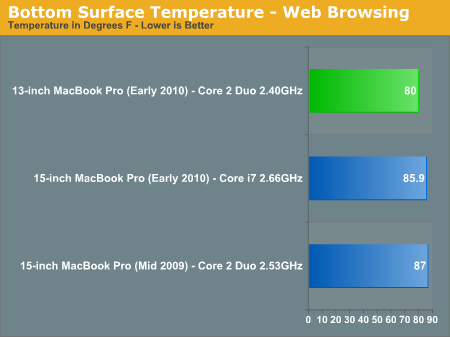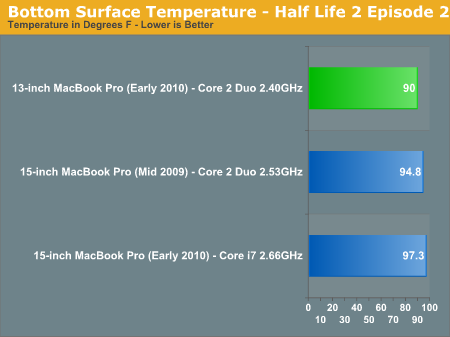Apple's 13-inch MacBook Pro (Early 2010) Reviewed: Shaking the CPU/GPU Balance
by Anand Lal Shimpi on June 9, 2010 12:15 AM EST- Posted in
- Mac
- Apple
- Intel
- MacBook Pro
- NVIDIA
Thermals: The Leg Test
At the end of my 2010 15-inch MacBook Pro review I mentioned that the bottom of the chassis can get uncomfortably warm. The higher peak power draw of the Core i5/i7 combined with the discrete GPU of the 15-inch MBP can result in more heat dissipated than the previous model.
The 13-inch MacBook Pro is built off a mature yielding 45nm Core 2 Duo CPU. Given how long Intel has been making this CPU it's safe to assume that this chip is running as cool as physically possible. While the mobile Core i5/i7 still have a lot of improving to go through. While the base of the 13-inch MBP can get warm under normal use (aluminum conducts heat very well...towards your lap), it's not as bad as the new 15-inch. I'd say it's pretty much on par with last year's models.

To quantify these differences I pointed an infrared thermometer at the bottom of a few MacBook Pros and reported the surface temperatures. They were taken in a room with an ambient temperature of 76F.

At idle the 13-inch MacBook Pro is about room temperature. The new 15-inch is a few degrees warmer and the 2009 15-inch is actually the warmest. Remember that the Core i7 in the 15-inch has a very low idle power thanks to Intel's power gating.

While browsing the web the temperatures climb up considerably. The new 13-inch is still cooler than anything else, while the new 15-inch model's power efficiency let's it run cooler than the previous model.

Running Half Life 2 Episode 2 changes things dramatically. Now all three machines are running at or above 90F and the 2010 15-inch MacBook Pro is finally warmer than the previous model. If I measure temperature near the exhaust fan on the notebooks the new 15-inch model peaks at 105F compared to 99F for the previous generation and 92F for the 13-inch.
In all cases the new 13-inch MacBook Pro keeps surface temperatures under control. In most situations the 2010 15-inch MBP is actually cooler than the previous generation, it's only when the dGPU is active or under heavy load that the surface temperature can go well above what the older model would do.










93 Comments
View All Comments
oldbriones - Wednesday, June 9, 2010 - link
Glaringly missing in display evaluation is any mention of the viewing angle. Anandtech probably knows that the supposedly "Pro" models have cheap TN LCD type thus resulting in crappy viewing angles. I expect Anandtech to educate its readers about availability of better screens so that manufacturers will respond to the market demand.Zok - Wednesday, June 9, 2010 - link
Good point, but when was the last time you've seen a laptop not sporting a TN LCD?Penti - Wednesday, June 9, 2010 - link
Only tablet-PCs don't and they are only on IPS-based tech since recently and in smaller sizes, as far as I'm aware of there is no 15" low power laptop panel in existence or being manufactured. They can't use something that aren't manufactured, and a display like that isn't in the catalogs of the Korean and Taiwanese panel manufacturers and are frankly out of most of theirs capability. Many of them simply don't make any IPS screens at all. Haven't seen PVA panels in those sizes and power envelope or anywhere near.IPS screens in devices like iPad was unheard of before LG put one together for Apple and hard to imagine. As netbooks and low cost devices use TN panels and e-readers use reflective technology.
Every photoguy knows the macbooks screens aren't worth a shit and that they need a calibrated external screen for referencing and work. So I hope it doesn't come as a surprise to anybody. The MBP screens aren't worse then any others. But it's still pretty useless for a lot of things. Any way that's what the review of monitors is for. They have done more detailed reviews of laptop screens too, but they only confirm that they are horrible. I'm pretty sure also that the screens for high-end tablet PCs isn't that good when it comes to color accuracy their usage is for viewing angles. And that isn't everything.
Penti - Wednesday, June 9, 2010 - link
And when I say based on IPS (IPS-based) I mean AFFS panels. They exist for up to 14". They are actually 262k color panels, while they have good viewing angles though. LG haven't invented a unique macbook screen yet.BlendMe - Wednesday, June 9, 2010 - link
Now that Apple is shipping the iPad and iPhone 4 with IPS panels it might not take to long till they move the tech up to their MacBook line. The iMac already have it but they're not power limited like laptops.ksherman - Wednesday, June 9, 2010 - link
"Every photoguy knows the macbooks screens aren't worth a shit..."That all depends. if you shoot in AdobeRGB, yeah you would be left wanting. I shoot almost exclusively in sRGB because that's what everyone seems to want anyway. As such, near 80% coverage of the AdobeRGB spectrum works just fine.
The bigger problem is an uncalibrated display. Calibrate the display and it will get you close enough in almost ever situation.
Of course though, it always depends on your medium/use for the pictures. I shoot for newspapers. They compress the details right out of the pictures online and the half-tone process kills and color correction or detail anyway.
If I shot for a magazine, it might be a different story. I'd have a lot more money and probably wouldn't be editing and transmitting from my car more often than not.
Anyway, I love my (first gen) unibody 15" MacBook Pro, but I'm lusting after the matte high-res display and awesome battery life.
bji - Wednesday, June 9, 2010 - link
What an interesting job you must have compared to those of us who sit in front of a computer in a cubicle all day ...rpottol - Monday, June 14, 2010 - link
IPS were dropped from the Thinkpads because they could no longer be obtained in the quantities that they needed them, Apple would need them in far greater quantities (given that they were only on a few high end Thinkpads, as opposed to what apple ships).We may long after them, but for now, we are stuck with the cast offs from the TV market.
oldbriones - Thursday, June 10, 2010 - link
It was only a few years ago (granted that is a long time in tech-years) that there were beautiful high quality IPS LCD options on laptops such as IBM/Lenovo T43, T60, etc. Lately most consumers got seduced into cheap but seriously compromised (display-wise) machines, and then suffer afterward searching for that elusive head and body tilt to view the movie at. Then again, many people probably don't even know what they are missing.Stokestack - Thursday, June 10, 2010 - link
The asinine glossy screen is a much bigger defect. What is with Apple's continued ignorance on this matter? I'm using a MacBook Pro with a glossy screen right now, and it is abysmal in ALL lighting conditions. From a pitch-dark room to a sunny office.To charge extra for a matte option on the other two MBPs is bad enough, but then they don't even offer it on the computer that's most likely to leave the house and be used in a variety of lighting. There's no excuse, because the size of the computer has nothing to do with this feature.
Sad.